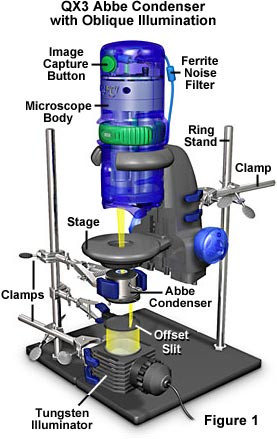QX3 Advanced Digital Image Gallery
Oblique Transmitted (Hoffman) Illumination
The technique known as oblique transmitted illumination uses direct light from a single azimuth of the condenser light cone to allow illumination of the specimen from one side only. The net effect is to reveal details in an otherwise almost invisible, colorless specimen in pseudo-relief or three-dimensional rendition.

Oblique lighting causes the zeroth order light waves to be shifted to a position just within the periphery of the objective, which allows additional diffracted orders (or sometimes just a single diffracted order) to be included in the objective's rear focal plane. These diffracted orders are on a single side of the zeroth order and, because of the obliquity, the diffracted orders on the opposite side fail to enter the objective front lens. The effect is similar to that observed in research-grade microscopes equipped for the technique of Hoffman modulation contrast, described in detail in the Molecular Expressions Microscopy Primer.
Images presented in this gallery were obtained with a Hoffman-style substage condenser fitted with an offset aperture slit, which provides illumination from an oblique angle with respect to the optical axis of the QX3 microscope. Digital images were recorded with the QX3 interactive software operating from the Live View menu. In the case of birefringent specimens, a polarizer was added beneath the Hoffman condenser and an analyzer was placed in front of the QX3 lens cover. In many instances, a full-wave retardation plate was inserted between the specimen and the analyzer before capturing images.
Adult Flea - Fleas thrive in a warm and humid environment and, while wingless, they can jump as high as two feet. Approximately one percent of an entire flea population exists in the adult stage, making it critical to treat the entire environment when dealing with an infestation.
Black Rot of Grape - Black rot, caused by the fungus Guignardia bidwellii is one of the most serious diseases of cultivated grapes in the eastern United States, especially in warm, humid areas.
Citric Acid - Citric acid is a colorless organic tri-carboxylic acid that is commonly found in citrus fruits such as lemons, limes, and oranges. Crystallites of citric acid assume a colorful pseudo-three dimensional appearance with this illumination technique.
Ephedrine - Ephedrine is a common drug that is used to treat the symptoms of asthma, chronic bronchitis, emphysema, and other lung diseases as well as to relieve coughs, wheezing and clogged breathing tubes.
Gramicidin Crystallites - Gramicidin is a mixture of three antibacterial polypeptides that work together to form a channel that spans cell membranes. The antibiotic increases the permeability of the bacterial cell membrane to inorganic cations by forming a network of channels through the normal lipid bilayer of the membrane.
Human Cheek Epithelial Cells - The skin that lines the mouth is called the buccal muscosa and is composed of squamous epithelial cells that divide about once every 24 hours. These cells secrete mucin, a mucopolysaccharide that is the principal constituent of mucus, which helps keep the interior of the mouth moist in addition to the salivary glands. The individual cells have a flat, irregular shape and a very thin membrane, which becomes more visible with oblique illumination.
Malonic Acid - Also called propanedioic acid, malonic acid is a dibasic organic acid whose diethyl ester is used in biosynthesis of vitamins B1 and B6.
Molten Wax Crystallites - Waxes are typically long-chain aliphatic hydrocarbons, which have melting points that increase with molecular weight. Partially crystallized molten wax was imaged using Hoffman-style oblique illumination to increase contrast in the lower digital image of these unstained specimens.
RU-486 (Mifepristone) - Commonly known as "the morning after pill", RU-486 (or mifepristone) is a synthetic prostaglandin derivative that has recently been found useful in obstetrics.
BACK TO THE INTEL PLAY ADVANCED DIGITAL IMAGE GALLERY
